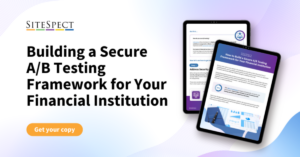5 A/B Testing Challenges for Media & Entertainment Apps & Devices [+ Solutions]
By Kevin Plankey
September 13, 2023
Share
Today, 77% of companies are running A/B tests on their websites. Why? Studies show that testing to create a better user experience can increase conversions by a whopping 400%!
And when it comes to media and entertainment apps, the story rings true again. In an industry where memorable user experiences are the currency of success, A/B testing becomes not just a valuable tool, but a strategic asset. The ability to fine-tune content, features, and designs based on user behavior and preferences can make the difference between an app that shines in the spotlight and one that fades into obscurity.
In this blog, we’re looking at 5 of the unique A/B testing challenges faced by developers and marketers in the media and entertainment industry. Along the way, you’ll get innovative solutions to combat these common challenges and thrive in this competitive industry. But first, let’s start with a high-level overview of the process.
A/B Testing Apps is Hard!
One of the main challenges of A/B testing your apps is the sheer complexity involved in the overall process. Here’s a brief overview of what your testing strategy might involve:
- SDK Installation: You typically need to install a new Software Development Kit (SDK) on top of the existing ones, while ensuring compatibility with your tech stack.
- App Mods: Each new A/B test often requires modifications to be made to the app itself, like changing content, updating features, or revamping the design.
- App Store Re-Submissions: For the changes to take effect, you need to submit the updated version for approval. This process can take weeks and even result in refusal.
- User Adoption: Even after gaining approval, there’s no guarantee that users will quickly update to the new version of your app.
- Multiple Apps and Devices: For media and entertainment companies managing a portfolio of apps across various devices, it’s necessary to balance the sometimes overwhelming workload.
There’s simply no way around it: A/B testing apps is hard! Unless you have the right tools and solutions that have you covered. Let’s dive into the fine details of the 5 most common challenges of A/B testing (and how to solve them).
#1 – Juggling Multiple SDKs
An often overlooked challenge in A/B testing in media apps is the management of multiple Software Development Kits (SDKs).
Many apps frequently rely on various SDKs to integrate features like analytics, advertising, and social media sharing. When you add A/B testing SDKs into the mix, it can become an overloaded process. Managing these multiple SDKs also drives higher costs, more dev cycles, and requires companies to maintain larger teams that possess highly specialized skill sets. This extensive library of changing SDKs also makes experimentation and innovation within the app ecosystem almost impossible.
Plus, different SDKs may not always play nicely together. These compatibility issues can lead to crashes, performance problems, or unexpected behaviors. This can quickly throw all the trust you’ve built up with your users out the window.
As an API transformation engine, SiteSpect enables teams to A/B test and change the experience of any app on any device without having to deploy/manage a single SDK. This patented approach of making changes in the flow of traffic translates to less dev time, cost, and risk. By eliminating the need for multiple SDKs, you reduce the app’s size and complexity, leading to less development time and a more efficient development process while keeping the costs associated with experimentation low.
Plus, our solution integrates seamlessly with your existing tech stack, making it easy to collaborate with your team and manage A/B tests without disrupting the workflow.
#2 – Managing App Store Re-Submissions
Continuous A/B testing to improve your app performance is a key component to delivering the best user experience possible.
You launch your test, receive the data, and then… you need to make feature updates based on what the A/B testing data revealed. Great! Your testing worked and revealed a few areas for improvement. Traditionally, teams that want to release new updates or features need to go through a tiresome app store resubmission process. This drives complexity, cost, and restricts innovation.
It can take days to even weeks to get the green light (or refusal) and see your changes reflected across platforms. This time spent waiting for app store approvals hinders the ability to quickly iterate and test new features, designs, or content variations. These delays can result in missed opportunities and user dissatisfaction. So what if you could bypass the need to resubmit to app stores while still rolling out app changes?
With SiteSpect, you can A/B test as much as you want, adding features and making all the updates you want along the way—without having to resubmit to app stores. Changes appear immediately with far less friction, time, and cost for both the organization deploying the apps and the users consuming them.
Since our solution sits in the flow of traffic between the servers and devices, you can conduct A/B tests at the server level to make real-time changes to your app’s content and user experience without touching the codebase.
Create your A/B tests. Get your results. Rapidly iterate without delay.
#3 – Ensuring Users Stay Updated
Be honest. How often do you check for app updates on your devices? In the world of A/B testing, having an outdated version of your app doesn’t help anyone. Users miss out on important features; You miss out on collecting valuable data. It’s a lose-lose.
You launch the test, resubmit to the app store (if you’re not a SiteSpect user), get approval, and… nothing happens. This is because users need to consistently update their apps. Many users might even completely ignore updates they consider to be of little value to them. Waiting on them to update their apps means you won’t receive immediate feedback on the changes you’ve implemented. This can slam the brakes on your optimization efforts.
Unless you have SiteSpect. Our solution gives you access to deploy changes instantly, without relying on the actions of users. Your A/B tests will take immediate effect once you hit publish, bypassing the need to rely on your users to hit the update button.
If for some reason a new iteration doesn’t go as planned, you can easily revert to the previous version without your users even knowing what’s happened behind the scenes. Embrace a more agile approach to A/B testing and start optimizing your user experience in real-time.
#4 – Maintaining a Consistent Experience Across Devices
With the technology of today, people can enjoy their media on a smartphone, tablet, smart TV, or many other devices. Most people would agree—it’s great to have these various options.
But this poses a specific challenge for developers: keeping the user experience consistent and engaging across a diverse array of devices. Each device has various levels of capabilities and technologies, plus a multitude of different screen sizes. This makes it especially tricky to optimize and A/B test content presentation. What might look stunning on the big screen, might not translate well to a 7” smartphone. So how do you keep the experience consistent across devices?
SiteSpect’s Omnichannel solution gives organizations the ability to quickly and easily A/B test across any platform on any device. With the power to perform SDK-free remote configuration and adjust the layout, images, and content to fit various screen sizes and orientations, you can maintain a consistent experience from the tiny phone screen to the largest TVs without skipping a beat.
When it comes to the analytics of your A/B tests, your omnichannel users who see the same experience across devices are not double-counted or missed in SiteSpect’s reporting. With our solution’s consistency across multiple devices, you’ll be able to enhance your customer experience, all backed by the best data available.
#5 – Staying One Step Ahead
Staying relevant in the media and entertainment industry is a challenge all on its own, even though A/B testing can significantly help.
The industry is in a constant state of flux—new devices, platforms, and technologies appear regularly. The A/B tests you perform today might not be relevant in the near future due to the speed of innovation. To combat this, SiteSpect employs an adaptive testing approach that continuously monitors user behavior and adapts tests in real-time, keeping you relevant.
But are your A/B testing strategies scalable as your apps grow? Can your current solution keep up with growing demand? At SiteSpect, it’s simple. Our solution is built to scale as you grow. Whether yours is a niche app or used by millions of people, our architecture can handle the load, providing a seamless testing experience as your audience expands.
To truly future-proof your app, SiteSpect includes predictive insights. This helps you anticipate user trends and behaviors, allowing you to proactively adapt your app’s content and features. This forward-thinking approach coupled with SiteSpect will ensure you always have one step into the future.
Final Thoughts
While vital to the success of your app’s user experience, A/B testing still has a few challenges you’ll inevitably face along the way. As backed by the stats, performing these A/B tests to improve your user experience is crucial to staying competitive in the media and entertainment industry.
As you’ve learned along the way, SiteSpect’s A/B testing solution has been created to not only help you bypass these issues, but also give you the tools and insights needed to reach new heights. Ready to experience the difference for yourself? Book your free SiteSpect demo and get started today.
Share
Suggested Posts
Subscribe to our blog:





